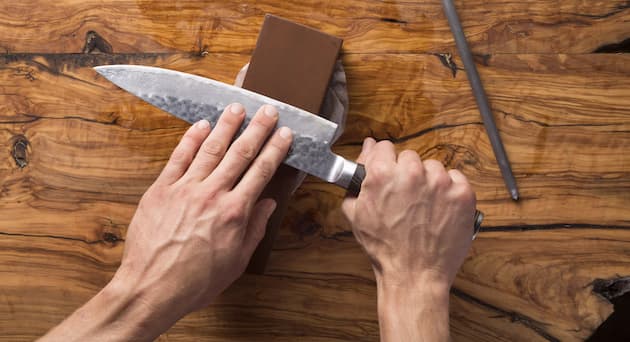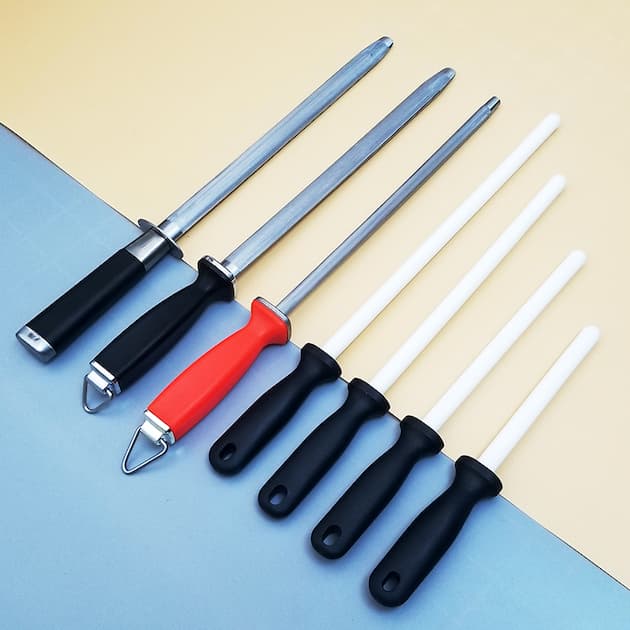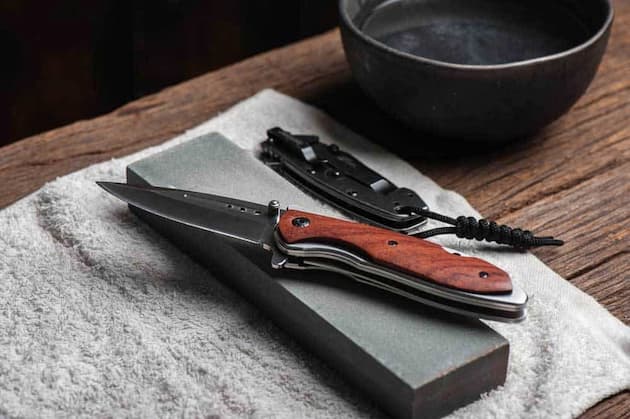Keeping Your Edge: A Guide to Knife Sharpeners
Your pandemic culinary endeavours have taken a toll on your kitchen knives. And you might have noticed that it requires some effort to chop an onion or split a tomato if you haven’t given them any tender loving care recently—or ever. Nope, you’re not losing your touch. A dull blade is likely to blame, and it’s a downright safety risk.
When and Why to Sharpen Your Knives

A sharp knife is a safe knife. You can have your favourite set professionally sharpened or go for a DIY option. If you choose the latter, you will need a good and reliable sharpener. The best knives sharpener will keep your edge in the kitchen while allowing easier, more fluid movements with less hand, wrist, and arm fatigue when cutting meat or vegetables.
Using a dull knife, instead, can put you in peril and make things harder to do. Cutting, slicing, or dicing your ingredients may require more strain and effort if a blade’s edge, or bevel, isn’t correctly sharpened. This could result in the knife’s slipping and possibly causing an injury.
Regularly sharpening your knives, on the other hand, will keep them in excellent condition, enhancing their usability and safety. Moreover, you can save money by keeping and sharpening dull knives rather than throwing them away and buying new ones.
While keeping up with your knives and sharpening them when necessary is essential, it’s equally crucial to avoid over-sharpening. It can be difficult to gauge when and how much to hone your knife, but it’s generally advised to sharpen your blades every few months, or whenever you notice that the blade of your knife is dull or isn’t cutting as effectively as it used to.
Types of Sharpeners

You will have no difficulties finding the ideal type of knives sharpener as there is a wide range of options available. However, choosing the best one will depend on several factors, including your budget, the kind of knives you already own, how often you use them, and how interested you are in giving them the proper care. The good news? You will end up with a knife that is sharper than when you began.
Manual Sharpeners
Handheld or pull-through sharpeners are other names for manual sharpeners. As the name suggests, you must physically move the blade through the opening of these sharpeners to sharpen it.
Since they don’t operate automatically or electrically, manual or on-the-go styles typically have one to three sharpening channels and a D-shaped grip to keep them steady while in use.
Knives are typically sharpened in the first channel, with finer abrasives used in the subsequent sharpening channels to either further the sharpening or occasionally hone the blade.
Most of the pull-through or handheld sharpeners have predetermined angles, which is beneficial if you lack expertise or are still learning. They’re not as simple to use as an electric sharpener, but they’re still simpler than using a whetstone.
Since they are smaller than electric sharpening tools, travelling cooks can easily store or transport them in a drawer. They are also more reasonably priced. However, knives with serrated blades should not be sharpened manually or with a handheld device.
Electric Sharpeners
Of all the sharpening techniques, using an electric sharpener for knife is the most practical so far. Electric models are simple to use, exert little effort, and don’t require any prior knife-sharpening expertise.
They have two or more ducts or slots, and inside are rotating sharpening stones that grind and sharpen the blade. Each channel has a varying amount of grit because its purpose is to make the blade sharper than the one before it. Many electric knife sharpeners have angle guides to make sure you’re inserting your knife at the correct angle, which relies on the blade you’re using.
Even though they’re very practical kitchen accessories, electric sharpeners for knife have some drawbacks. They can occupy a lot of room on your kitchen countertop and are typically costlier than other sharpeners due to the ease with which you can obtain a well-honed blade after using them. The lifetime of your knife may also be shortened by utilizing the electric alternatives.
Whetstones
Honing blades with whetstones or sharpening stones offers the utmost control. Different types of stones can be used; some can be used dry, some must first be submerged in water, and others must be used in conjunction with oil. Which technique a sharpening stone employs is crucial information to have when making a purchase.
Sharpening stones are also the most challenging to use. The knife is moved back and forth across the stone’s surface until it is sharpened. The stone should be set down on a firm surface, therefore, many come with a holder or platform.
Many people believe that sharpening with a whetstone will yield the finest results because you have total control over the process. Of course, this is true only when they are utilized correctly. However, they can take a lot of time to use and require a lot of knowledge and comprehension.
The Blade Angle

The direction at which you sharpen your knife is very important. Each knife is unique and can differ based on the manufacturer or even the knife style. Angle guides that arrive with some sharpeners may assist you in positioning the blade at the proper angle during sharpening. However, if you utilize knives that don’t come with blade angle guides then you should keep in mind the elevation at which you want to sharpen your knife.
In this regard, the blade loses sharpness as the inclination increases. The knife’s bevel also grows much sharper as the angle gets smaller. Most kitchen knives typically have an angle of about 20 degrees or about 10 degrees on each edge. The elevation at which a knife should be sharpened depends on what it will be used for.